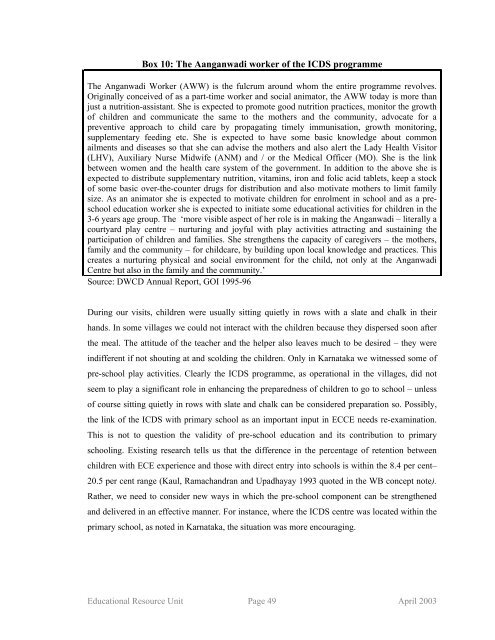Snakes and Ladders - ERU Consultants Pvt. Ltd.
Snakes and Ladders - ERU Consultants Pvt. Ltd.
Snakes and Ladders - ERU Consultants Pvt. Ltd.
Create successful ePaper yourself
Turn your PDF publications into a flip-book with our unique Google optimized e-Paper software.
Box 10: The Aanganwadi worker of the ICDS programme<br />
The Anganwadi Worker (AWW) is the fulcrum around whom the entire programme revolves.<br />
Originally conceived of as a part-time worker <strong>and</strong> social animator, the AWW today is more than<br />
just a nutrition-assistant. She is expected to promote good nutrition practices, monitor the growth<br />
of children <strong>and</strong> communicate the same to the mothers <strong>and</strong> the community, advocate for a<br />
preventive approach to child care by propagating timely immunisation, growth monitoring,<br />
supplementary feeding etc. She is expected to have some basic knowledge about common<br />
ailments <strong>and</strong> diseases so that she can advise the mothers <strong>and</strong> also alert the Lady Health Visitor<br />
(LHV), Auxiliary Nurse Midwife (ANM) <strong>and</strong> / or the Medical Officer (MO). She is the link<br />
between women <strong>and</strong> the health care system of the government. In addition to the above she is<br />
expected to distribute supplementary nutrition, vitamins, iron <strong>and</strong> folic acid tablets, keep a stock<br />
of some basic over-the-counter drugs for distribution <strong>and</strong> also motivate mothers to limit family<br />
size. As an animator she is expected to motivate children for enrolment in school <strong>and</strong> as a preschool<br />
education worker she is expected to initiate some educational activities for children in the<br />
3-6 years age group. The ‘more visible aspect of her role is in making the Anganwadi – literally a<br />
courtyard play centre – nurturing <strong>and</strong> joyful with play activities attracting <strong>and</strong> sustaining the<br />
participation of children <strong>and</strong> families. She strengthens the capacity of caregivers – the mothers,<br />
family <strong>and</strong> the community – for childcare, by building upon local knowledge <strong>and</strong> practices. This<br />
creates a nurturing physical <strong>and</strong> social environment for the child, not only at the Anganwadi<br />
Centre but also in the family <strong>and</strong> the community.’<br />
Source: DWCD Annual Report, GOI 1995-96<br />
During our visits, children were usually sitting quietly in rows with a slate <strong>and</strong> chalk in their<br />
h<strong>and</strong>s. In some villages we could not interact with the children because they dispersed soon after<br />
the meal. The attitude of the teacher <strong>and</strong> the helper also leaves much to be desired – they were<br />
indifferent if not shouting at <strong>and</strong> scolding the children. Only in Karnataka we witnessed some of<br />
pre-school play activities. Clearly the ICDS programme, as operational in the villages, did not<br />
seem to play a significant role in enhancing the preparedness of children to go to school – unless<br />
of course sitting quietly in rows with slate <strong>and</strong> chalk can be considered preparation so. Possibly,<br />
the link of the ICDS with primary school as an important input in ECCE needs re-examination.<br />
This is not to question the validity of pre-school education <strong>and</strong> its contribution to primary<br />
schooling. Existing research tells us that the difference in the percentage of retention between<br />
children with ECE experience <strong>and</strong> those with direct entry into schools is within the 8.4 per cent–<br />
20.5 per cent range (Kaul, Ramach<strong>and</strong>ran <strong>and</strong> Upadhayay 1993 quoted in the WB concept note).<br />
Rather, we need to consider new ways in which the pre-school component can be strengthened<br />
<strong>and</strong> delivered in an effective manner. For instance, where the ICDS centre was located within the<br />
primary school, as noted in Karnataka, the situation was more encouraging.<br />
Educational Resource Unit Page 49 April 2003












